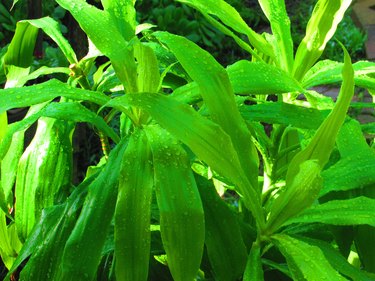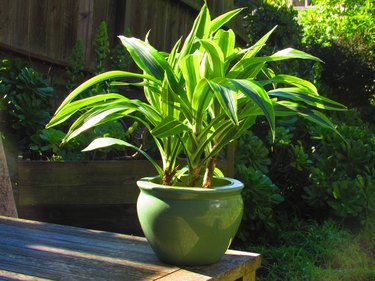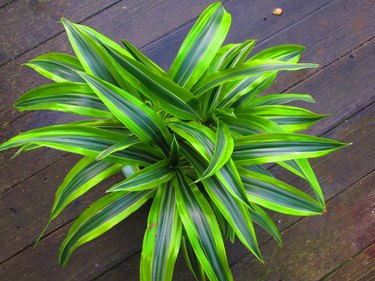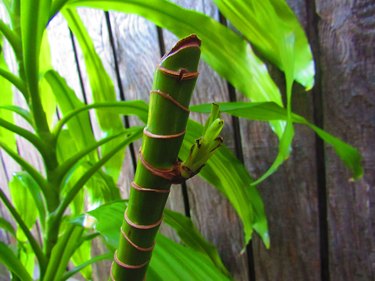

The corn plant is trending these days as a gorgeous, easy-to-grow houseplant, but that doesn't mean it's the new kid on the block. I've had one for years! In fact, these large, bright plants—known botanically as Dracaena fragrans—have been up adding color and charm to European and American homes for centuries. Their stems grow upright like little palm trees and produce long, lance-shaped leaves.
Commonly topping out at 4 to 6 feet tall and fairly narrow in width, a potted corn plant can fit into almost any corner. Given its easy-care ways, convenient size and bright foliage, it's hard to find an equal as a houseplant, which might account for the corn plant's current moment in the limelight.
Video of the Day
Video of the Day
Dracaena fragrans Highlights
- Easy Care?: Yes!
- Light + Location: Light shade to bright indirect light
- Watering: Water regularly to keep evenly moist but not wet
- Growth Rate: Slow-growing
- Flowering: Fragrant white flowers but not a reliable bloomer indoors
- Pet-Safe?: No! Toxic to dogs and cats

All About the Corn Plant
Does a corn plant grow corncobs? No, it does not. The Dracaena corn plant is unrelated to the actual corn plant, so don't expect a harvest in the fall. Some people claim the "corn plant" got its common name because the bare stem looks like an elongated corn cob; others think the long, narrow leaves hang on the stems like corn in the veggie garden.
In fact, the Dracaena plant is native to tropical Africa. That means it is hardy outdoors only in the warmest zones—USDA hardiness zones 10 to 12—but it also thrives in ordinary household temperatures. Corn plants are extremely flexible about sun exposure too. Don't make the mistake I did and think those large, lush leaves need hours of sunlight! The result was burned leaves and a very unhappy plant. My plants now live in a shady corner of my apartment.

Types of Corn Plants
If you head out to the garden store and ask for a corn plant, you are likely to get a Massangeana (Dracaena fragrans 'Massangeana'). This is an appealing plant with lush green leaves that can have a paler stripe down the center of its leaves.
But a few newer cultivars are really turning heads. These varieties have more and brighter leaf colors that make for a visually stunning display. Two of the rising stars have lime in their leaves.
- Lemon lime (Dracaena fragrans 'Lemon Lime') has exceptional leaf shades. The vibrant lime green on the leaf edges is a stunning contrast to the deep green heart of the leaf, which is itself circled in ivory.
- Limelight (Dracaena fragrans 'Limelight') also makes the running. This cultivar's leaves turn a pale green, almost neon green, as they mature.
Care and Feeding of a Corn Plant
One thing I've learned over years of tending houseplants is that "easy care" means different things to different people. But there's no need to be skeptical when it comes to the low-maintenance Dracaena corn plant. Once you set it up for success, it is almost indestructible.
The keys to that success include making sure its basic cultural requirements are met. That means having a location out of direct sun, a container with good drainage, quality potting soil that drains well and adequate water. Let's talk a bit more about each of these requirements.

Best Location for Corn Plant
This plant is a rock star, but it doesn't need to be treated as one. Its siting requirements are simple: protection from strong winds (not an issue indoors) and a location far from heat and out of direct sun. The ideal spot has bright, filtered light, but even low light will do. My corn plants have been in a shady corner of the bedroom for years, and they are bright and happy, although the leaf variegation has faded.
Potting Soil for Corn Plant
Again, the corny is undemanding, and any peat-based potting soil will do. Good drainage is essential, so check the pot bottom for holes before you buy it.

Air Temperature and Humidity for Corn Plant
Average household temperatures of 60° to 70°F will keep your corn plant happy. I place my plants on the back patio in summer but bring them inside at night when temperatures dip. Some experts recommend high humidity levels for the corn plant—between 40 and 50 percent!—so if you want to invest in a humidifier, you can achieve this. I have never provided this, and it hasn't seemed to have hurt my plants at all. My sole nod to this humidity issue is to give my corn plants a shower every month with the garden hose. This adds humidity while cleaning dust off their leaves.
Watering Your Corn Plant
Most houseplant enthusiasts know that low care is different from no care. Expect to give your corn plants a drink every few weeks. But watering on a schedule is not necessary or desirable. Rather than watering every Friday morning, just poke a finger an inch or two into the top of the soil. When it's dry to two inches, water the plant until the water runs out the drainage holes in the container's bottom.
Unlike more fussy houseplants, cornies will forgive your indiscretions. Forget to water for three or four weeks? The plants will shrug it off.
Best Fertilizer for Corn Plant
Some experts suggest fertilizer for corn plants. But is it really necessary? I personally have known more corn plants suffering from too much fertilizer than plants suffering from too little. I've never fertilized mine, and they still grow at a reasonable clip. If you decide to fertilize, use a balanced liquid fertilizer on a monthly basis only during spring and summer. If the leaves turn yellow, you've used too much!

Propagating and Transplanting
Propagating a corn plant is so quick and easy, it feels like magic! It involves clipping off the top of a stem, rooting it in water, then transplanting it into its own container. I never tried this until my corn plant grew so tall that one of the stem tops hit the ceiling. If this happens to your plant—or it is just looking a little leggy—here's what to do:
- Use a sharp pruner to cut off the top third of each stem you want to shorten. Make the cuts under a set of leaves.
- Place the cut segments in a vase of tepid water. Keep the vase topped up and change the water at least every week. Roots should appear in short order.
- When the roots are an inch long, plant the stem segments in potting soil. (Two or three look great planted together.) Keep the soil moist. The plants should establish themselves in a matter of weeks.
The cut stem will sprout a new leaf on a node under the cut. This fills in the top of the plant nicely.

Repotting Your Corn Plant
When you bring your corn plant home from the garden store, you'll want to think about changing it to a new container. Tip the soil ball out of the pot and see if the roots are showing. If so, loosen them. Get a slightly larger pot, add a few inches of moist soil, then set the new plant root ball on top. Fill in the sides of the pot with soil, but stop at least an inch from the top to give yourself room to water.